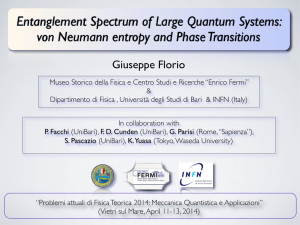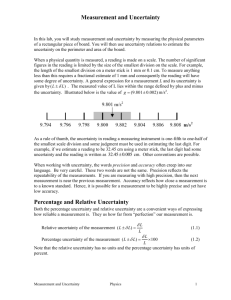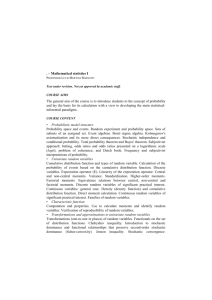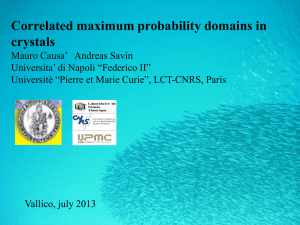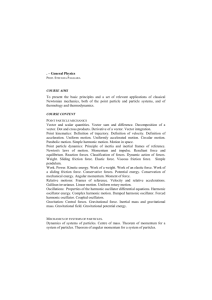3) Varentropy for -exponential distribution
advertisement
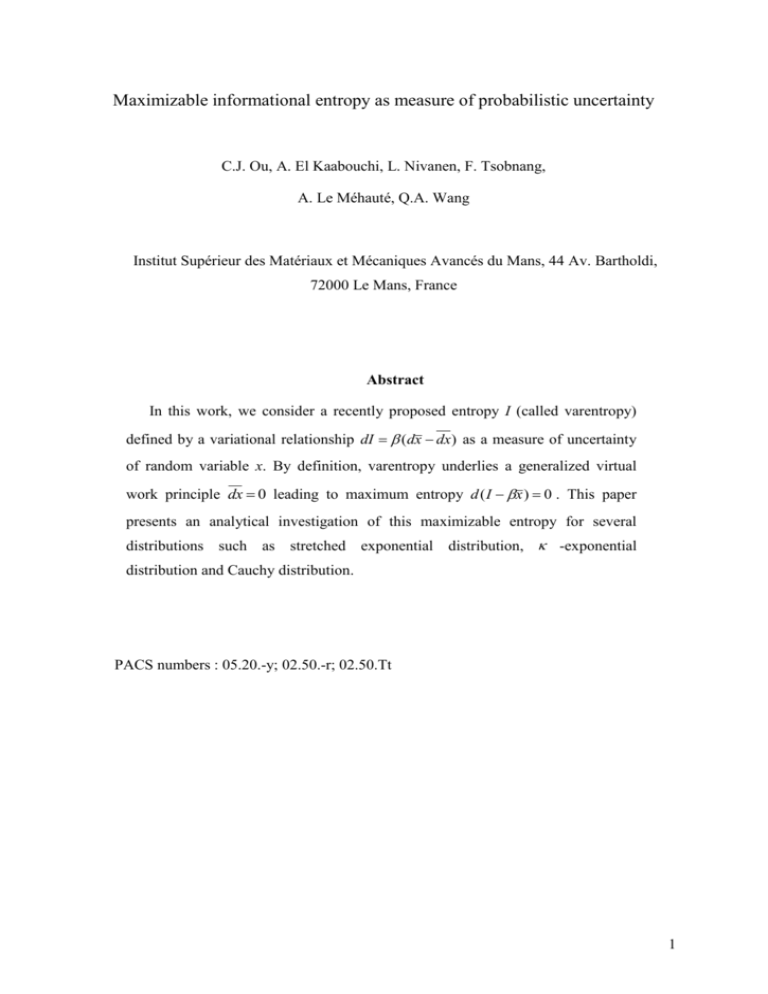
Maximizable informational entropy as measure of probabilistic uncertainty
C.J. Ou, A. El Kaabouchi, L. Nivanen, F. Tsobnang,
A. Le Méhauté, Q.A. Wang
Institut Supérieur des Matériaux et Mécaniques Avancés du Mans, 44 Av. Bartholdi,
72000 Le Mans, France
Abstract
In this work, we consider a recently proposed entropy I (called varentropy)
defined by a variational relationship dI (dx dx) as a measure of uncertainty
of random variable x. By definition, varentropy underlies a generalized virtual
work principle dx 0 leading to maximum entropy d ( I x ) 0 . This paper
presents an analytical investigation of this maximizable entropy for several
distributions such as stretched exponential distribution, -exponential
distribution and Cauchy distribution.
PACS numbers : 05.20.-y; 02.50.-r; 02.50.Tt
1
1) Introduction
The term 'information' has been used as a measure of uncertainty of probability
distribution in information theory[1][2]. In this sense, it is often called entropy with the
detriment to possible confusion with the entropy of the second law of thermodynamics which
has another specific physical definition for equilibrium system. In the present study of the
relationship between uncertainty and probability, we would like to use the term 'varentropy' in
order to distinguish the present uncertainty measure from both 'information' and 'entropy' for a
reason we will explain below.
The search for the functional relationship between entropy and associated probability
distribution has since long been a question in statistical and informational science. There are
many relationships directly postulated or established on the basis of the presumed properties
of entropy. The reader can refer to the references [1] to [10] to see several examples of
entropies proposed on the basis of postulated entropy properties. Among the numbers of
proposed entropies, the Shannon informational entropy I p i ln p i is singled out as
i
unique maximizable formula of uncertainty measure as claimed by Jaynes in its maximum
entropy principle (maxent) [12][13]. Nevertheless, it is actually believed that other formula
can be useful in some physics contexts. There are already many statistical theories constructed
on the maximization of entropies which are postulated or deduced from assumed properties of
entropy[6-10]. The correctness of these entropies is then verified through the validity of
corresponding probability distributions often derived by using maxent.
The extension of maxent raises several questions about the validity and limit of that logic.
The first question is why entropy, or uncertainty measure, can be maximized for assigning
probability distribution. The second question is which entropies, among the numbers of
entropies formula proposed up to now, each measuring a kind of probabilistic uncertainty, can
be maximized, and why? Within the maxent of Jaynes, these questions are answered with
unique Shannon entropy advocated by considering the anthropologic interpretation of
subjective probability. However, these arguments are at odds with the frequency interpretation
of probability widely accepted by physicists. Another questions relevant to the above ones is,
given the variety of probability distribution observed in Nature, what is the right uncertainty
measures which can yield them at maximum?
A possible way of answering these questions is to invert the logic of maxent, i.e., instead
of postulating entropy property and formula and then maximizing them with additional
2
principles and hypothesis concerning the constraints (of which the underlying reasons are
often ambiguous so that certain constraints are somewhat arbitrary) to get useful probability,
we only define a generic measure. This methodology was tested in [11] with a variational
definition dI (dx dx) of a measure I of uncertainty for the simple situation of one
random variable x, where is a characteristic constant. I is called varentropy due to its
variational definition implying a maximum state satisfying an extended Lagrange-d’Alembert
variational principle of virtual work dx 0 [14]. Varentropy is different from the usual notion
of information in that it is defined without any assumption about its physical signification
(e.g., missing information or ignorance), its property (additive or not) and functional form. It
is also different from the thermodynamic entropy of second law because it is not necessarily
related to heat. Nevertheless, it can be the second law entropy in a special case of equilibrium
thermodynamic system.
In this work, we investigate further the varentropy for three well known probability
distributions: the stretched exponential distribution, the -exponential and the Cauchy
distribution. The first is often observed in complex relaxation process of nonequilibrium
system [15]. The second is a probability distribution proposed in the case of relativistic
complex system [7]. The third one is often used to describe the line shape in spectroscopy
[16].
2) Varentropy for stretched exponential distribution
According to its definition, with the hypothesis of complete normalization pi 1 and
i
the expectation x pi xi , the varentropy can be given by (let 1 ).
i
dI dx dx xi dpi ,
(1)
i
where {xi , i 1,2,3} represent the possible value of random variable x at different state
with corresponding probability { pi , i 1,2,3} . The stretched probability distribution is
given by
pi
1
exp xi
Z
with 0 ,
(2)
where Z is a normalization constant or sometimes called the partition function. From Eq.(2)
we can easily get
3
1
(3)
1
(4)
1
.
xi ln
p
Z
i
Substituting Eq.(3) into Eq.(1) we can get
1
dpi .
dI ln
p
Z
i i
Then the varentropy can be written as
(5)
1
1
1
dpi
I dI ln
Z
i
pi Z
1
1, ln( pi Z ) C ,
i
where (a, z ) t a 1 exp( t )dt is the incomplete gamma function which will reduce to
z
complete gamma function at the limit z 0 , and C is the integral constant. In order to
determine C we consider a system without uncertainty as a special case of Eq.(5). Suppose
the system has only two states i 1 and 2 with p1 1 and p2 0 , the uncertainty of the
system is zero requires
1 1
1 1
0 1, ln Z 1, ln 0 C ,
Z
Z
(6)
From definition of incomplete gamma function, the second item in the right hand side of
Eq.(6) tend to zero. Now from Eq. (6) we can get the integral constant
(7)
1 1
C 1, ln Z .
Z
Substituting Eq.(7) into Eq.(5) yields
1
1
1 1
I 1, ln( pi Z ) 1, ln Z .
Z i
Z
(8)
This is the varentropy for the stretched exponential distribution. In fact if we choose a
variable replacement as: xi a bxi' where the parameters a and b are associated with the
Lagrange multipliers, then the normalization constant Z exp( xi ) can be replaced by
i
Z ' exp (a bxi' ) 1 . So Eq.(8) can be rewritten as
i
4
1
1
'
I 1, ln( pi ) 1 ,
i
(9)
'
with the corresponding distribution function
(10)
pi' exp (a bxi' ) .
Eqs.(9) and (10) are in accordance with the results in Ref.[18] while the derivation given here
seems more straightforward.
3) Varentropy for -exponential distribution
With the help of the definition of -exponential function [19]
exp { } ( x) x 1 2 x 2
1/
,
(11)
the -exponential distribution is given by
pi
1
exp { } ( Ei ) ,
Z
(12)
where is a deformation parameter. E i and represent the energy of the system at the i-th
microstate and the chemical potential of the system, respectively. It’s obviously that Eq.(12)
will reduce to the Maxwell-Boltzmann distribution at the 0 limit. One easily get the
inverse function of p i as
Ei
1 ( pi Z ) ( pi Z )
2
.
(13)
Since Ei represent the energy of each microstate of the system, it’s can be considered as a
random variable. Then from Eq. (1) the information measurement of such a system can be
written as
dI Ei dpi .
(14)
i
where is a constant with inverse dimension of energy. Then Ei is a dimensionless
variable. Substituting Eq. (13) into Eq. (14) yields
( p i Z ) ( p i Z )
dI
2
i
dpi .
(15)
The varentropy of the -exponential distribution directly reads,
5
I c( ) pi1 c( ) pi1 C,
(16)
i
where
c( )
Z
.
2 (1 )
(17)
In the same way we can determine the integral constant C c( ) c( ) . These results
appearing in accordance with the one in Ref. [19] was not by chance. In fact the definition of
Eq. (1) is very general and by this method we can get even more different measurements of
uncertainty (sometimes it was called entropic forms by other authors) based on the different
observed probability distributions in the nature.
In the above calculation, the random variable is energy as in the original version of statistics. The result is however valid for any random variable.
4) Varentropy for Cauchy distribution
The Cauchy distribution function is given by
pi
1
x x 2
0
1 i
,
(18)
where x0 is a constant which specifies the location of the peak of Cauchy distribution, and
is the half-width of the line shape of distribution at half-maximum. For the sack of
convenience, we can choose a standard Cauchy distribution at x0 0 , so Eq.(18) reads
pi
1
1
,
Z 1 xi / 2
(19)
where Z is a normalization constant. If xi is a continuous random variable in the region
, ,
the normalization constant Z will be equal to after a simple integral. From
Eq.(19) we can get the definition of mean value of {xi } which does not exist in the original
definition of Cauchy distribution,
x
1 A
x
dx ,
A
Z 1 x / 2
(20)
with
6
Z AA
1
1 x / 2
(21)
dx ,
where A is the maximum of random variable xi . We can easily write
xi
1
1 . xi
pi Z
(22)
1
1
pi Z
Substituting Eq. (22) into the definition of varentropy, i.e., Eq.(1), after integration, one gets
I
xi
C
arctan(
x
)
i
Z i 1 xi2
pi Z
Z i
1
1 arctan
pi Z
(23)
1
1 C
pi Z
where
C
1
1
arctan(
1
)
Z
1
.
Z
Z
Z
2
(24)
From Eqs. (23) and (24) we can get the curve of uncertainty measurement I with respect of
the probability distribution. As shown in Fig.1, for a two states system the I first increased
with the increasing of probability and then decreased. At pi 0 and pi 1 the uncertainty
measurement are zero since the system was absolutely determined at one state and there has
no uncertainty. So there exist maximum values for I with different , it means that the
expressions of Eqs. (23) and (24) can be maximized and consequently one will get the Cauchy
distribution if the Maxent method was adopted with the constraints of normalization condition
and the definition of expectation of random variables, i.e. x pi xi .
i
5) Concluding remarks
The work in the present paper is an extension of the work in Ref. [11]. Based on the
definition of uncertainty measurement for random variable, i.e. Eq. (1), we can derive several
different entropic forms corresponding to different probability distribution functions. It’s very
easy to verify that all these entropies can be maximized with the constraints of mean value of
random variable {xi } and the normalization condition of probability distribution. All these
will result to the corresponding distributions which have been observed in the nature. It’s
worth to point out that the calculations in this paper are not inverse process of Maxent. First,
7
there was not any concrete functional form required in the definition of uncertainty
measurement, it means that Eq. (1) is very general and can be use to derive many different
entropic forms only based on the existed distributions but no other additional assumptions. It
can give reasonable explanations for some entropic forms such as stretched exponential one
[9] which have been used without any introduction.
Second, we prefer “uncertainty
measurement” rather than “entropy” which may be confused with the one of thermodynamics.
If and only if Maxwell-Boltzmann distribution was adopted, the corresponding uncertainty
measurement reduced to Shannon entropy, which was firstly maximized by Jaynes. And Eq.
(1) now has more concrete physical meaning; it’s nothing but the first law of thermodynamics.
Acknowledgements
This work was supported by the Region des Pays de la Loire of France under grant number
2007-6088.
References
[1]
M.D. Esteban, Kybernetika, 31(1995)337
[2]
C.E. Shannon, The Bell System Technical Journal, 27(1948)379
[3]
A. Rényi, Calcul de probabilit´e,(Paris, Dunod, 1966)P522
A. Wehrl, Rev. Mod. Phys., 50(1978)221
[4]
J. Harvda and F. Charvat, Kybernetika, 3(1967)30
[5]
Z. Daroczy, Information and control, 16(1970)36
[6]
C. Tsallis, J. Statis. Phys., 52(1988)479
[7]
G. Kaniadakis, Phys. Rev. E, 296 (2000)405
[8]
Q.A. Wang, Chaos, Solitons & Fractals, 12(2001)1431;
Q.A. Wang, Entropy, 5(2) (2003)
[9]
C. Anteneodo and A. R. Plastino, J. Phys. A 32 (1999)1089
[10] S. Abe, J. Physics A: Math. Gen., 36(2003)8733-8738
[11] Q.A. Wang, J. Physics A: Math. Theor., 41(2008)065004
8
[12] Jos Uffink, Can the maximum entropy principle be explained as a consistency
requirement, Studies in History and Philosophy of Modern Physics, 26B (1995)
223-261
[13] E.T. Jaynes, The evolution of Carnot's principle, The opening talk at the EMBO
Workshop on Maximum Entropy Methods in x-ray crystallographic and biological
macromolecule structure determination, Orsay, France, April 24-28, 1984; Gibbs
vs Boltzmann entropies, American Journal of Physics, 33,391(1965) ; Where do
we go from here? in Maximum entropy and Bayesian methods in inverse problems,
pp.21-58, eddited by C. Ray Smith and W.T. Grandy Jr., D. Reidel, Publishing
Company (1985)
[14] Q.A. Wang and A. Le Méhauté, From virtual work principle to maximum entropy
for nonequilibrium Hamiltonian system, arXiv:0712.2583
[15] J. C. Phillips, Rep. Prog. Phys. 59, 1133 (1996)
[16] E. Tuncer, M. Furlani, B.E. Mellander, Resolving distribution of relaxation times
in Poly(propylene glycol) on the crossover region, Journal of Applied Physics 95,
3131-3140 (2004)
[17] Q.A. Wang, Chaos, Solitons & Fractals, 12(2001)1431;
Q.A. Wang, L. Nivanen, A. El Kaabouchi, J.P. Badiali, A. Le Méhauté, Physica A
386 (2007)92-100
[18] S. Abe, Generalized entropy optimized by an arbitrary distribution, arXiv: condmatt/0211437 (2002).
[19] G. Kaniadakis. Non Linear Kinetics underlying Generalized Statistics. Physica A
296, 405 (2001).
9
Fig 1. The variation of Cauchy varentropy versus probability distribution for a two states
system and for different values of .
5
4
I
3
2
1
0
0.0
0.2
0.4
0.6
0.8
1.0
pi
10
